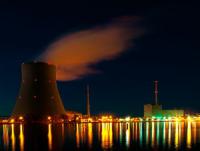-
Identifying sources of coastal resiliency
As extreme weather events become more commonplace, regions of the world that get hit the hardest are often left scrambling to put the pieces of their homeland back together. ASU’s Sian Mooney, an economist, recently returned from a trip to Cuba, where the economist attended a tri-national workshop on the theme: “Enhancing Resilience of Coastal Caribbean Communities.” The workshop’s participants have been charged with defining and identifying sources of coastal resiliency and then working to implement them in the region over the next few years.
-
-
Artificially cooling the planet could have devastating effects
Geoengineering — the intentional manipulation of the climate to counter the effect of global warming by injecting aerosols artificially into the atmosphere — has been mooted as a potential way to deal with climate change. Proposals to reduce the effects of global warming by imitating volcanic eruptions could have a devastating effect on global regions prone to either tumultuous storms or prolonged drought, new research has shown.
-
-
Improving sensor accuracy to prevent overload of the electrical grid
Electrical physicists from Czech Technical University have provided additional evidence that new current sensors introduce errors when assessing current through iron conductors. It’s crucial to correct this flaw in the new sensors so that operators of the electrical grid can correctly respond to threats to the system. The researchers show how a difference in a conductor’s magnetic permeability, the degree of material’s magnetization response in a magnetic field, affects the precision of new sensors.
-
-
New Zealand energy firm invests $10 million in Iron Dome maker
New Zealand-based energy and communications infrastructure provider Vector invested $10 million in the Israeli company that developed the Iron Dome. Some of the technologies that power Israel’s remarkable protection against projectiles will be used by Vector as part of its IoT (Internet of Things) approach to optimizing management and control services.
-
-
Sandy five years later. What have we learned?
Five years ago, Post-tropical Cyclone Sandy struck at high tide, driving catastrophic storm surge into coastal New Jersey and New York unlike anything seen before. Thirty-four New Jersey residents lost their lives. Hundreds of thousands of homes and businesses were destroyed, causing over $62 billion in damage. Five years later some areas have recovered. Some have not.
-
-
Nuclear energy programs do not increase likelihood of nuclear weapons proliferation: Study

Contrary to popular thought, nuclear proliferation is not more likely to occur among countries with nuclear energy programs, according to new research. In a historical analysis of the relationship between nuclear energy programs and proliferation from 1954 to 2000, the study finds that the link between the two has been overstated. “The findings suggest that international efforts to manage the proliferation risks of nuclear energy programs have been quite effective,” says the study’s author. “Even when countries become more technically capable of developing nuclear weapons due to an energy program, they can often be restrained by timely intelligence and the prospect of sanctions.”
-
-
As wildfires expand, fire science needs to keep up
In the month of October nearly 250,000 acres, more than 8,000 homes and over 40 people fell victim to fast-moving wildfires in Northern California, the deadliest and one of the costliest outbreaks in state history. Now is the time to wrestle with hard questions. Why did communities that were deemed safe suffer major damage? Should they be rebuilt in the same way? Are there better ways to fight extreme fires and limit their impact? How can emergency planners prepare better for scenarios where full evacuation is not possible? Fire conditions are constantly evolving, and basic research coupled with engineering solutions must keep up. Designing more resilient communities and infrastructure and protecting people more effectively are not onetime goals – they are constant. Currently nations are failing to meet the challenge, and impacts on communities are increasing.
-
-
MSU urged to pull the plug on an “eco-terrorism” video game
Michigan State University’s award-winning computer game development lab has developed a new computer game called “Thunderbird Strike.” Dr. Elizabeth LaPensee, the game’s designer, says that, among other things, the game is designed to “bring awareness to pipeline issues and contribute to the discontinuation of [Enbridge’s] Line 5.” Enbridge’s Line 5 is a 645-mile, 30-inch-diameter pipeline that travels through Michigan’s Upper and Lower Peninsulas. In the game, players get to blow up pipelines. Oil industry officials argue that the game, in effect, encourages players to engage in acts of domestic terrorism.
-
-
Israeli software gives New York power plants “Iron Dome” protection against failures
An Israeli company that developed the software for Israel’s Iron Dome anti-missile system is working with the New York Power Authority to prevent unexpected shutdowns. New York State Robert Moses Niagara Power Plant, Blenheim-Gilboa Pumped-Storage Power Plant, and a 500 MW plant in Queens now have software based on the software that runs Iron Dome.
-
-
Fire-resistant coating to prevent failure in steel building fires
A few extra coats of “paint” could be all that the steel in a building needs to prevent itself from buckling and failing in a fire. Scientists came up with this idea when they were figuring out a commercially viable solution to protect reinforced concrete against underground fires. After two years of intensive research and development by the interdisciplinary team, an affordable 3-in-1 coating that offers enhanced fire and corrosion protection was invented.
-
-
Electricity sector uncertainty requires new decision-making tools
Before it was stayed by the U.S. Supreme Court in February 2016, the Clean Power Plan offered state electric utilities and their regulators a degree of certainty as they confronted a rapidly changing market and technology landscape. Although not all agreed with the U.S. Environmental Protection Agency’s approach, the Clean Power Plan’s predictable long-term emissions reduction targets provided clear goals to evaluate investments in traditional generation sources like coal and nuclear energy and resources on the rise like natural gas, wind, solar, and distributed generation.
-
-
Battelle completes 15-year CO2 storage project at Mountaineer Power Plant
One of the first tests for geologic storage of carbon dioxide at a commercial, coal-fired power plant has concluded, more than fifteen years after it began, completing a journey from an initial exploratory well to successful operations and site closure. The Mountaineer project helped establish the technical viability of carbon capture and storage (CCS) to reduce greenhouse gas emissions from coal-fired power plants, and to store carbon dioxide in geologic layers with limited prior data.
-
-
With more superstorms predicted, there’s a dream project to keep New York above water
Five years ago, on 29 October 2012, the coasts of New York and New Jersey were devastated by a rare late-October superstorm. Superstorm Sandy killed seventy-two people in the United States and caused more than $70 billion in damage. Over the next thirty years, floods of 7.4 feet or more, which used to occur in the New York area once every 500 years and are now happening every 25, could strike as frequently as every five years. Scientists say that sea-level rise caused by climate change is the biggest factor. One big idea to prevent massive destruction from the next, inevitable superstorm: A constellation of giant underwater gates which would rise in New York Harbor and beyond when disaster looms.
-
-
Why were California’s wine country fires so destructive?

As of late October more than a dozen wildfires north of San Francisco had killed more than 40 people, burned approximately 160,000 acres and destroyed more than 7,000 structures. The path of the destructive 2017 Tubbs fire in Napa and Sonoma counties mirrors that of the Hanley fire of 1964. Strikingly, though, no lives were lost during the Hanley fire and only 29 structures were destroyed. Why did these two fires, 50 years apart, burn on the same general landscape, under similar extreme winds, with such different human impacts? Fire scientists will study these events intensively to parse out the relative importance of various factors. But it is clear that two factors probably were major contributors: wind and population growth. Drought and warmer climates have made wildfires a year-round hazard in California. Expanded urban development, in tandem with hot winds, seems to be the primary reason for the destruction this year.
-
-
The “Really Big One”: How a 9.0 Cascadia earthquake could play out
One of the worst nightmares for many Pacific Northwest residents is a huge earthquake along the offshore Cascadia Subduction Zone, which would unleash damaging and likely deadly shaking in coastal Washington, Oregon, British Columbia and northern California. The last time this happened was in 1700, before seismic instruments were around to record the event. So what will happen when it ruptures next is largely unknown.
-
- All
- Regional
- Water
- Biometrics
- Borders/Immig
- Business
- Cybersecurity
- Detection
- Disasters
- Government
- Infrastructure
- International
- Public health
- Public Safety
- Communication interoperabillity
- Emergency services
- Emergency medical services
- Fire
- First response
- IEDs
- Law Enforcement
- Law Enforcement Technology
- Military technology
- Nonlethal weapons
- Nuclear weapons
- Personal protection equipment
- Police
- Notification /alert systems
- Situational awareness
- Weapons systems
- Sci-Tech
- Sector Reports
- Surveillance
- Transportation
Advertising & Marketing: advertise@newswirepubs.com
Editorial: editor@newswirepubs.com
General: info@newswirepubs.com
2010-2011 © News Wire Publications, LLC News Wire Publications, LLC
220 Old Country Road | Suite 200 | Mineola | New York | 11501
Permissions and Policies
Editorial: editor@newswirepubs.com
General: info@newswirepubs.com
2010-2011 © News Wire Publications, LLC News Wire Publications, LLC
220 Old Country Road | Suite 200 | Mineola | New York | 11501
Permissions and Policies
